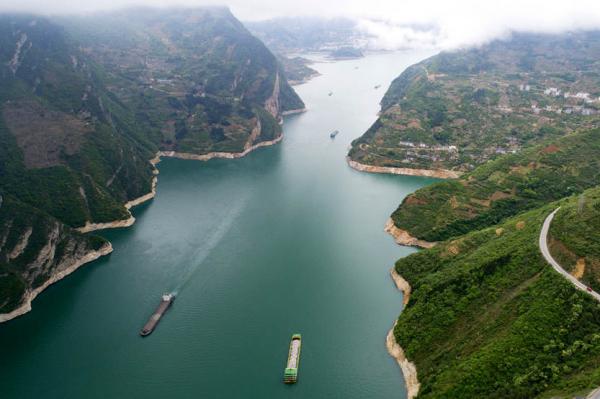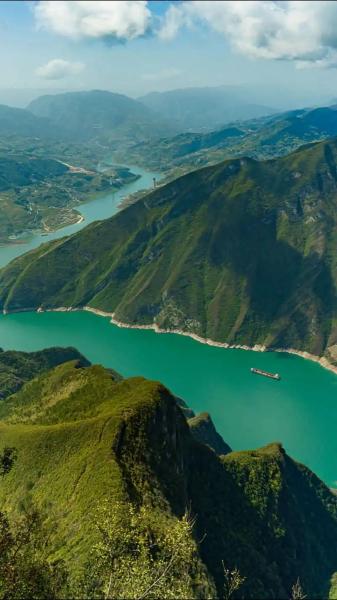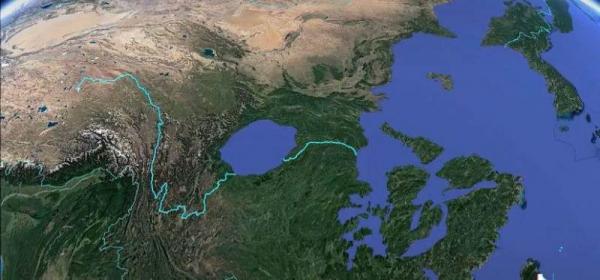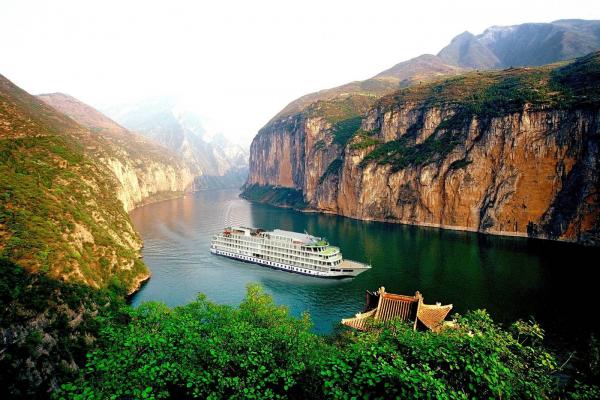Everything about Yangtze River: Facts, Cities, Attractions & Animals
Emanating from the wild windswept snowfields of its source on Qinghai-Tibet Plateau, the mighty Yangtze River in China winds its way through 11 provinces and municipalities before emptying into the East Sea. Being referred as the Chang Jiang (literally Long River) for many generations, it has always had symbolic and practical significance for the Chinese. Nearly 6300 km (about 4000 miles), the river is China 's main artery, supporting a third of our people. It also serves as the country's major commercial waterway.
What is the Yangtze River?
The Yangtze River can be divided into three parts:
The Upper Reaches begins from the source of Qinghai Province to Yichang in Hubei Province ( 4500km ). It is the most attractive part of the river, with imposing mountain ranges, unbroken ravines, dangerous rapids and charming landscape. Along this 200-kilometer-long (130 miles) stretch, the river passes through the Three Gorges. In the Qutang Gorge, the river is only 100 meters wide with some 60 meters (200 feet) hydraulic gradient. In the Wu Gorge, mountains rise to a height of 500 to 1,000 meters (1,600 to 3,300 feet). In Xiling Gorge, it was featured with turbulent waves and dangerous shoals. Now this has become a history after the completion of China's largest engineering project - the Yangtze Three Gorge Dam.
The Middle Reaches is from Yichang to Hukou at the mouth of Poyang Lake in Jiangxi Province, a distance of about 1,000 kilometers (620 miles). This region features countless twists and turns, flat lands with so many tributaries and lakes including two largest lakes in China: the Dongting and the Poyang . During rainy season, the waters play an important role in channeling the flood.
The Lower Reaches is from Hukou to the estuary ( 800km ). The landscape in the river's lower course is typified by a flat delta plain, crisscrossed by canals and waterways. The region has been known for centuries as the "Land of Fish and Rice". Because of a port named Yangzi in ancient times, this stretch has given rise to another name "Yangtze" with which missionaries and colonialists adopted and as a result, became established in Europe as the name of the whole river.

Basic Facts about Yangtze River
How Do You pronounce Yangtze River in Chinese & English?
Pronunciation In Chinese
Its pinyin is Yáng zǐ Jiāng. When pronounced in Chinese, the first character Yáng has a second tone, similar to the English word “young” but with a rising tone. The second character zǐ has a third tone, which first falls and then rises, similar to the English word “dsuh.” The third character Jiāng has a first tone, which is flat, similar to the English word “jee-ahng” when elongated.
In everyday use, Chinese people often abbreviate it as “Long River,” pronounced “Chang Jiang.” Chang (cháng) means “long”; Jiang (jiāng) means “river”.
Pronunciation In English
It it easier. The phonetic transcription of Yangtze is /ˈjæŋtsi/.
The English name “Yangtze” originates from the pronunciation of “Yangtze River” in the Wu dialect spoken in the lower reaches of the Yangtze River (covering Shanghai, southern Jiangsu, northern Zhejiang, and southern Anzhui).
Where is the Yangtze River
If you have a Yangtze River map at hand, you can see clearly that the Yangtze River originates from the Tangula Mountains in Qinghai Province. Its source is located at the Jianggendiru Glacier, the foot of the Geladandong Peak, and in the forbidden zone of life known as Kekexili. It flows through Tibet, Yunnan, Sichuan, Chongqing, Hunan, Hubei, Jiangxi, Anhui, Jiangsu, and Shanghai, and ends in the East China Sea.
From west to east, it crosses the Qinghai-Tibet Plateau, the Hengduan Mountains, the Yungui Plateau, the Sichuan Basin, the Jianghan Plain, and the Yangtze River Delta Plain. These major geographical regions span three elevation steps, with an east-west elevation difference of over 6,000 meters. The Yangtze River basin spans an area between the Tropic of Cancer and 35 degrees north latitude.
The Yangtze River accounts for one-third of China's water resources. With numerous tributaries, it nourishes most of southern China.
>> Recommended 22-day Wonders of China Tour with Yangtze River Cruise

How Long is the Yangtze River?
The Yangtze River is 6,300 km (about 4,000 miles) long. The upper reaches extend 4,500 km (about 2,796 miles) from the source to Yichang. The middle reaches extend 1,000 kilometers (620 miles) from Yichang to Hukou. The lower reaches extend 800 km (about 497 miles) from Hukou to the East China Sea.
The Yangtze River (6,300 km) is approximately 350 km shorter than the world's longest river, the Nile (6,650 km), and approximately 100 km shorter than the world's second-longest river, the Amazon (6,400 km).
>> Related reading: Is Yangtze River Cruise Worth It? Top 7 Reasons to Take It
The History of Yangtze River
So, when was the Yangtze River formed? The oldest Yangtze River can be traced back to the Triassic period, approximately 200 million years ago. At that time, only parts of South China and North China were above sea level. The regions west of the Wu Gorge and Xiling Gorge, including the Qinghai-Tibet Plateau, were still submerged in the Tethys Sea, also known as the ancient Mediterranean Sea.
During the Indosinian Orogeny, the rudiments of the ancient Chinese continent began to take shape. As tectonic plates collided, the Qinghai-Tibet Plateau continued to rise, giving rise to the Kunlun Mountains, the Qilian Mountains, the Bayan Har Mountains, and the Hengduan Mountains, while the Qinling Mountains gradually formed. Concurrently, land began to emerge in the southern part of the lower Yangtze River basin, and the Yunnan-Guizhou region also rose, leading to the ancient Mediterranean Sea retreating westward on a large scale.
By around 30 million years ago, the Qinghai-Tibet Plateau had risen, the ancient Mediterranean Sea had disappeared, and the Yangtze River basin had been uplifted as a whole.

Yangtze River Flooding & Dam
The terrain and climate of the Yangtze River, combined with the dense convergence of its tributaries, created significant flood on the Sichuan Basin and the middle reaches of the Yangtze River every year, until the construction of the Three Gorges Dam in 1994.
A must-see attraction on the Yangtze River, the Three Gorges Dam is one of the largest water conservancy projects in the world, serving functions such as flood control, power generation, navigation, and water resource utilization. For decades, it has acted as a massive regulating valve, effectively reducing flood risks in the middle and lower reaches by controlling upstream water flow.
>> Recommended 11-day China Golden Triangle with Yangtze Cruise
China’s Yangtze River Delta
The Yangtze River Delta, located in the lower reaches of the Yangtze River in China, is an alluvial plain formed before the Yangtze River flows into the sea. It is one of the most economically developed and urbanized regions in China, with a GDP accounting for approximately 24% of the national total. It includes Shanghai, Jiangsu Province, Zhejiang Province, and Anhui Province, comprising a total of 41 cities.
By high-speed rail, you can reach Hangzhou, Suzhou, and Nanjing from Shanghai in just one hour, exploring the ancient water towns and tasting Chinese cuisines in Zhejiang and Jiangsu.
>> Recommended 7-day Shanghai Yangzte Cruise Tour Package

Cities by the Yangtze River
The main tourist cities along the upper reaches are Golmud in Qinghai.
The main tourist cities along the middle reaches are Luzhou, Chongqing, and Wanzhou in Sichuan, and Yichang and Wuhan in Hubei.
The main tourist cities along the lower reaches are Nanjing, Yangzhou, and Shanghai.
>> Recommended 15-day Sichuan+Yangtze Cruise Combo
The Yangtze River Wildlife
The Yangtze River basin boasts a diverse array of ecosystem types. The Sichuan-West River Valley Forest Ecosystem, the Southern Subtropical Evergreen Broadleaf Forest Ecosystem, and the Yangtze River Middle and Lower Reaches Wetland Ecosystem are globally significant biodiversity priority conservation areas. The Yangtze River Middle and Lower Reaches Wetlands serve as a critical overwintering site for over 100 species and more than one million individuals of internationally migratory waterbirds.
Rare and endangered plants account for 39.7% of China's total, and freshwater fish account for 33% of China's total. The region is home to rare animals such as the Chinese sturgeon, Yangtze finless porpoise, Yangtze alligator, giant panda, and golden monkey, as well as rare plants like the silver fir, metasequoia, and Davidia involucrata.
>> Recommended Shorter Yangtze Cruise
How to Visit the Yangtze River
There are many reasons to visit the Yangtze River. As one of the world's busiest inland waterways, the Yangtze River is not only a natural wonder but also a significant symbol of China's history, economy, and culture. There's no better way to experience of its grandeur than a Yangtze River cruise. Board a luxury Yangtze River cruise from Chongqing to Yichang for 3days and 4 nights (or longer itinerary to Shanghai) to get up close to the Three Gorges (Qutang Gorge, Wu Gorge, Xiling Gorge), Shennong Stream, and visit the Three Gorges Dam.
Additionally, from the Yangtze River Bridge in Wuhan, you can overlook the vast expanse of the river. At the Bund in Shanghai, you can gaze out at the ships passing through the Yangtze River estuary.
>> Recommended 16-day China Impression Tour with Yangtze Cruise

Famous Yangtze River Quotes
“I live at the head of the Yangtze River, while you live at the tail of the Yangtze River. I think of you every day, but I cannot see you. However, we drink the same water from the Yangtze River.”
“Endless falling leaves rustle down, and the Yangtze River rolls on endlessly.”
"Leaving from the city of White Emperor among the colorful clouds, I return to Jiangling in a single day across a thousand miles (with Yangtze River cruise).”
Yellow River VS Yangtze River
The Yellow River, with a total length of approximately 5,464 kilometers, is the second longest river in China after the Yangtze River. It is the ancient agricultural center of China, and regarded as the cradle of Chinese civilization.
Both the Yellow River and the Yangtze River originate in Qinghai (different places) and flow through Sichuan. However, the Yellow River then flows through Gansu, Ningxia, Inner Mongolia, Shanxi, Shaanxi, Henan, and Shandong before entering the Bohai Sea.
There are also different in color. The Yangtze River has clear water quality, while the Yellow River has a high sediment content and its water color is muddy yellow (hence the name).
>> Recommended 10-day Qinghai & Gansu Expedition